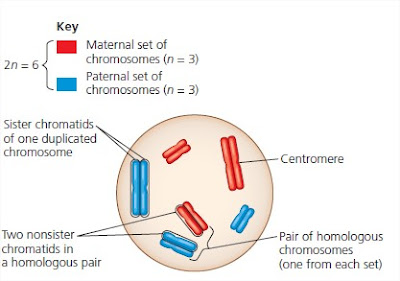In humans, each somatic cell has 46 chromosomes. During
mitosis, the chromosomes become condensed enough to be
visible under a light microscope. At this point, they can be
distinguished from one another by their size, the positions of
their centromeres, and the pattern of colored bands produced
by certain stains.
Careful examination of a micrograph of the 46 human
chromosomes from a single cell in mitosis reveals that there
are two chromosomes of each of 23 types. This becomes
clear when images of the chromosomes are arranged in
pairs, starting with the longest chromosomes. The resulting
ordered display is called a karyotype (Figure 13.3). The
two chromosomes composing a pair have the same length,
centromere position, and staining pattern: These are called
homologous chromosomes, or homologs. Both chromosomes
of each pair carry genes controlling the same inherited
characters. For example, if a gene for eye color is
situated at a particular locus on a certain chromosome, then
the homolog of that chromosome will also have a version of
the same gene specifying eye color at the equivalent locus.
The two distinct chromosomes referred to as X and Y are
an important exception to the general pattern of homologous
chromosomes in human somatic cells. Human females
have a homologous pair of X chromosomes (XX), but males
have one X and one Y chromosome (XY). Only small parts of
the X and Y are homologous. Most of the genes carried on
the X chromosome do not have counterparts on the tiny Y,
and the Y chromosome has genes lacking on the X. Because
they determine an individual’s sex, the X and Y chromosomes
are called sex chromosomes. The other chromosomes
are called autosomes.
The occurrence of pairs of homologous chromosomes in
each human somatic cell is a consequence of our sexual origins.
We inherit one chromosome of each pair from each parent.
Thus, the 46 chromosomes in our somatic cells are actually two
sets of 23 chromosomes—a maternal set (from our mother) and
a paternal set (from our father). The number of chromosomes in a single set is represented by n. Any cell with two chromosome
sets is called a diploid cell and has a diploid number of chromosomes,
abbreviated 2n. For humans, the diploid number is
46 (2n 46), the number of chromosomes in our somatic cells.
In a cell in which DNA synthesis has occurred, all the chromosomes
are duplicated, and therefore each consists of two identical
sister chromatids, associated closely at the centromere and
along the arms. Figure 13.4 helps clarify the various terms that
we use to describe duplicated chromosomes in a diploid cell.
Study this figure so that you understand the differences between
homologous chromosomes, sister chromatids, nonsister
chromatids, and chromosome sets.
Unlike somatic cells, gametes contain a single set of chromosomes.
Such cells are called haploid cells, and each has
a haploid number of chromosomes (n). For humans, the haploid
number is 23 (n 23). The set of 23 consists of the
22 autosomes plus a single sex chromosome. An unfertilized
egg contains an X chromosome, but a sperm may contain an
X or a Y chromosome.
Note that each sexually reproducing species has a characteristic
diploid number and haploid number. For example,
the fruit fly, Drosophila melanogaster, has a diploid number
(2n) of 8 and a haploid number (n) of 4, while dogs have a
diploid number of 78 and a haploid number of 39.
Now that you have learned the concepts of diploid and
haploid numbers of chromosomes, let’s consider chromosome
behavior during sexual life
Trending Post
3/footer/recent
Daftar isi penting
Cari Blog Ini
Most Recent
A Comparison of Mitosis and Meiosis
Mei 15, 2013DNA Cloning and Its Applications: A Preview
Mei 15, 2013Membuat wifi ad-hoc hosted network windows 8
Mei 08, 2013All Right Reserved Copyright ©



